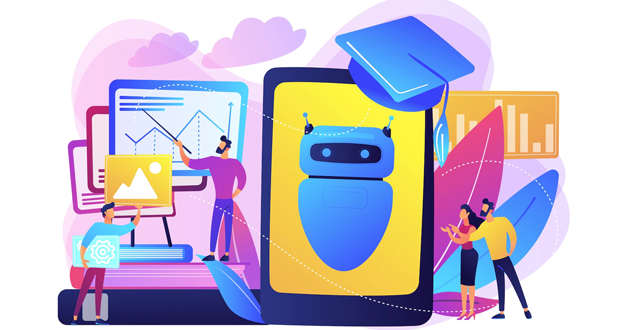Introduction
Artificial intelligence is a strategy to give computers the ability to think like people. The system mimics how a person would think logically, decide, observe, and learn from past experiences. One may say that the device/robot system is programmed to carry out difficult jobs effectively.
A technique used in artificial intelligence called machine learning is focused on how well software performs. To find hidden visions in data without being precisely programmed where to look and how to end, it uses methods from SNN, statistics, operation research, and physics.
Meaning of Ai
Artificial intelligence refers to a computer program’s or a machine’s capacity for thought and learning. It is a discipline of study that aims to make computers intelligent and a program that attempts to emulate humans.
Features of AI
- Removes boring duties – It implies that the system will carry out the same task again in response to numerous orders given to it without getting tired. It cuts down on an individual’s time and effort.
- Data consumption – The AI system uses a variety of data on diverse entities from a variety of sources. It is assumed that information entered the system simultaneously.
- Imitates Human Intelligence – As was already mentioned, AI is thought to mimic human intelligence in terms of thinking, observing, investigating, and drawing conclusions. Similar to humans, AI machines also comprehend commands and offer solutions in line with those interpretations.
- Ingenious – These devices are designed to detect their surroundings and respond appropriately. The information regarding upcoming events is also stored there.
- Prevent natural disasters – Artificial intelligence is employed in a variety of fields, including business, education, gaming, and others. It has now started taking action to increase how much it is used to stop natural disasters. During a calamity, the government may employ it. Once the system has been given information about past catastrophes, it will be able to forecast the approach of future disasters.
- Visual perception and Chatbots – The technology can identify a person’s face through biometric mapping. The data/knowledge from the database is compared. The method of resolving user problems via text or audio is known as a chatbot.
Advantages of AI
- High accuracy with less errors – AI systems are prone to less errors and high accuracy as it takes decisions as per pre-experiences / information.
- High Speed – These systems are of high speed and takes faster decision
- High Reliability – It is highly reliable and performs the same tasks multiple times with accuracy.
- Helpful for risky areas – It will help you or protect you from natural calamities and risky situations like defusing a bomb, tsunami, volcanoes
- Digital assistant – It assists the users digitally in terms of various e-commerce websites as per customer requirements, demand, taste, etc.
- Used as a Public Utility – Public utilities like self-driving cars, facial recognition as a security measure, natural language process to communicate with users in their respective languages.
Disadvantages of AI
- High Cost – Hardware and software requirements of AI are very expensive as it requires lots of maintenance to meet current global requirements.
- Less proactive – The system will do the work to which is trained or programmed.
- No feelings and emotions – It cannot have emotional attachments with the user and can cause harm with careless handling.
- High-dependency on machines – mental thinking and memory power has been reduced in humans as they are highly dependent on technological devices.
- Less creativity – Humans are more skilled than these machines and these machines can never match the creativity as humans do.
Meaning of Machine Learning
It is the area of artificial intelligence that can pick up new skills and improve upon old ones without having explicit programming.
Features in Machine Learning
- Continuous features – These are frequently utilized because they offer a more detailed representation of the data than category features do. Continuous features are more advantageous while modeling is being optimized. For instance, while purchasing a home, you may consider factors such as location, lot size, home age, style, and appliance condition. Numerical values are used to express these characteristics.
- Categorical or discrete features – These characteristics are used to classify something based on other characteristics. A number is used to denote each category.
In terms of this feature, there are two categories.
- Nominal, such as colors
- Ordinal, depending on ranking or rating: satisfied, neutral, or dissatisfied.
Raw data will be used for the features, which can be extracted from actual life. Not all issues can be resolved using raw data; some require encoding and presentation in various formats.
Advantages
- Quick analysis, prediction, and processing – Machine learning gives people the chance to make the correct choices at the right time. Consider optimizing the best deals for the company’s clients. Without the company having to spend time manually making the proper act possible for the clients, the customers will always be able to view the right offers.
- Widespread application – Machine learning has expanded its application across numerous industries, including sales, operations, analysis, forecasting, etc., with ease and fewer errors.
- Synchronized execution – ML will complete any variety of tasks in parallel with perfection.
- Potential for growth – Because we can’t foresee what will happen in the future and how things will change, AI and machine learning are always evolving.
- Decrease Time Complexity – Since the development of ML, the amount of time needed to perform various jobs has decreased. ML can now accurately finish any given activity in a matter of seconds, which would take an individual an inconceivable amount of time.
- Trends and Patterns Identification – In the modern world, we can see that many websites that sell products or showcase fashion trends display the goods and services in accordance with our tastes and preferences. The process is assisted by a machine learning algorithm that operates in the background, maintains track of all previous activities, performs analysis, and forecasts possible outcomes.
- Numerous applications – Virtually every industry and business rely heavily on machine learning. ML is used in a variety of fields, including government work, banking, the telecom industry, GPS monitoring, email filtering, grammar and spelling checks, plagiarism detection, and other things.
Disadvantages
- Data collection – It is rumored that significant sums of money are occasionally spent to gather data, and that data acquisition is difficult. The biggest problem with machine learning, according to some, is that when input is inconsistent, the entire system reacts incorrectly and poorly.
- Extremely error-prone – During the system’s training and testing phases, you must be extremely cautious when putting data into the system. Since the entire system operates under the premise of “garbage in, garbage out,” it should be clear, factual, and pertinent to the issue. In other words, the data input must be precise, or the outcome will be the same and the purpose of the study will not be served.
- Time-consuming – Time consumption is listed as one of the drawbacks of ML. Although the system algorithms are capable of processing enormous amounts of data with absolute precision, there are moments when the volume of data exceeds the server’s capacity. It takes an unusually long time to process, and a system crash could make matters worse.
- Huge sources – A substantial investment must be made in order to construct a full machine learning programme, since we require additional resources like data feeding, programmers to write code, testing environments, and much more.
- Excessive use harms mankind – since people are becoming increasingly dependent on machine learning and losing their sense of self. Due to their total reliance on technology machines, they have lost the ability to think critically in many situations.
Conclusion
Artificial intelligence affects people’s lives and society in both positive and harmful ways. From a positive perspective, AI is believed to enhance people’s quality of life by performing simple and complex tasks better than they can, making their lives easier, safer, and more effective. As we can see from the report mentioned above, AI is being used in a variety of industries to help people complete their tasks more quickly and easily.
We also observed from the benefits of AI that it performs jobs with a high level of accuracy, speed, and dependability; protects under risky circumstances; and offers security through facial recognition, fingerprints, and many other means. Focusing on its negative aspects, it is believed that AI creates serious privacy problems, encourages prejudice by standardizing individuals, and has a higher likelihood of increasing unemployment. The drawbacks of AI are that they are more expensive to maintain, need more hardware and software, and limit human inventiveness by requiring individuals to rely on it for the majority of their needs.
The subset of AI known as machine learning has also sped up and simplified human existence. Because its main goal is to accurately duplicate the knowledge and contributions of individuals, it relies on leveraging data and algorithms. In a number of sectors, including economics, statistics, data science, blockchain technology, etc., its introduction has brought miracles. There are advantages and disadvantages to adopting machine learning, as we can see.
By concentrating on its strengths, it has expanded its execution across a variety of disciplines, completing those tasks with greater accuracy and fewer mistakes, reducing the complexity of the work’s time requirements, and leaving room for future development. The biggest drawback of employing ML is that, like AI, it impairs people’s ability to think critically by making them constantly dependent on the technology and requiring significant resources to gather data and programme the system. It is clear that in order to minimize risks and improve oneself on a level with AI and machine learning, both must be handled carefully.
FAQ
It may handle a variety of common duties, including campaign reporting, performance, and many others. Artificial intelligence (AI), Natural Words Processing (NLP), Natural Language Generation (NLG), and Natural Language Understanding (NLU)-powered chatbots may interpret the user’s language and answer in a manner similar to that of a human.
There are 4 types of AI
- Reactive machines – it is one of the simplest levels in AI which reacts to some input with output. Steady machine learning models are reactive machines.
- Limited memory – It refers to the ability of an AI to store previous data/predictions to make better predictions.
- Self-aware – It is considered that this kind of AI exists only in stories, as it installs both immense hopes and fears into audiences. It has intelligence way beyond humans where they have to negotiate terms with the entity it created.
- Theory of Mind – It is found that this level of AI is yet to be completely evolved. At present, it’s in the first phase like partially reacting to humans’ thoughts and emotions.
With a 31.4 percent growth in positions for data scientists and mathematical scientists by 2030, which are essential to AI, the discipline of artificial intelligence has a bright future for career advancement. Due to the fact that machine learning engineers are the second most sought-after position in the industry, machine learning jobs are expected to increase over the next few years.
There are three types of machine learning.
- Supervised – In this type, historical input and output data is fed in an ML algorithm which processes in between each output/input that allows to shift the model to create output as desired.
- Unsupervised – It is very helpful in identifying patterns and uses data to make decisions.
Predictive models can be created using this type of machine learning.
- Reinforcement – Algorithms grasp data by interacting with its environment and get a positive or negative reward in return.
The cyclical procedure that data science initiatives adhere to is called the machine learning life cycle. It outlines each step a company should take to benefit from machine learning and artificial intelligence (AI) and provide useful economic value.







